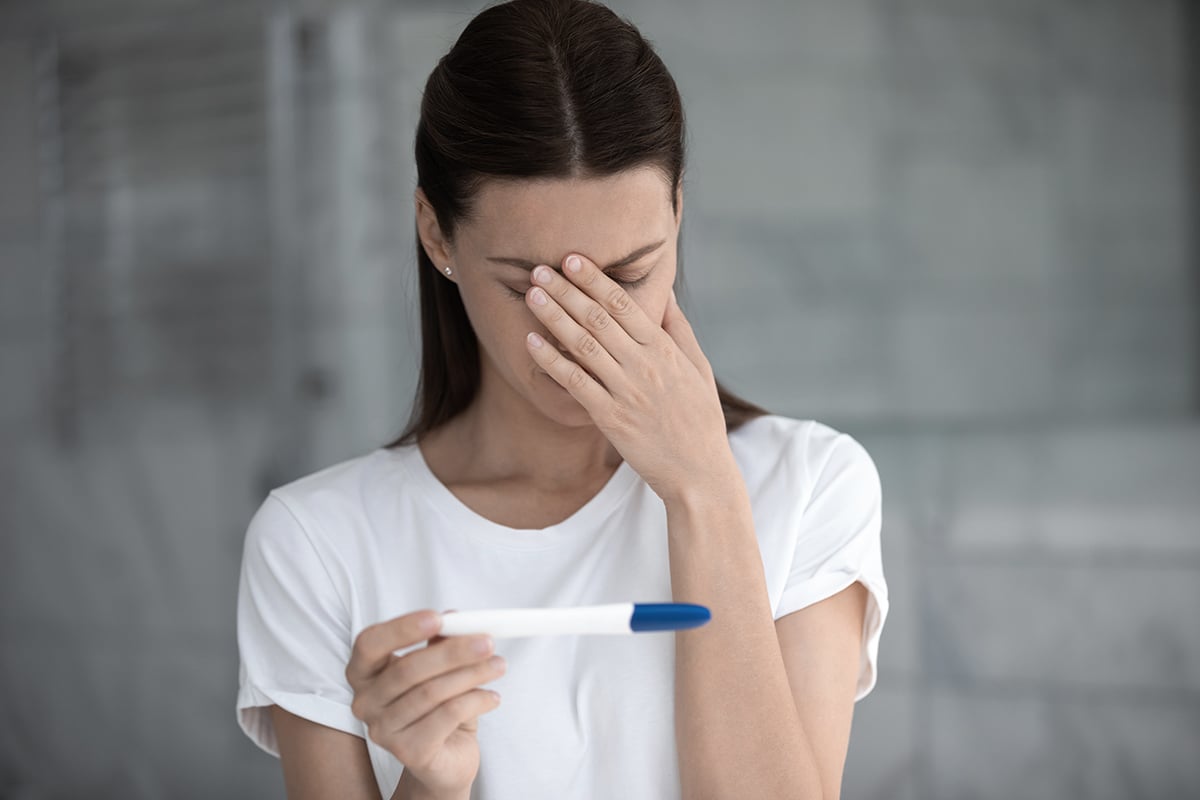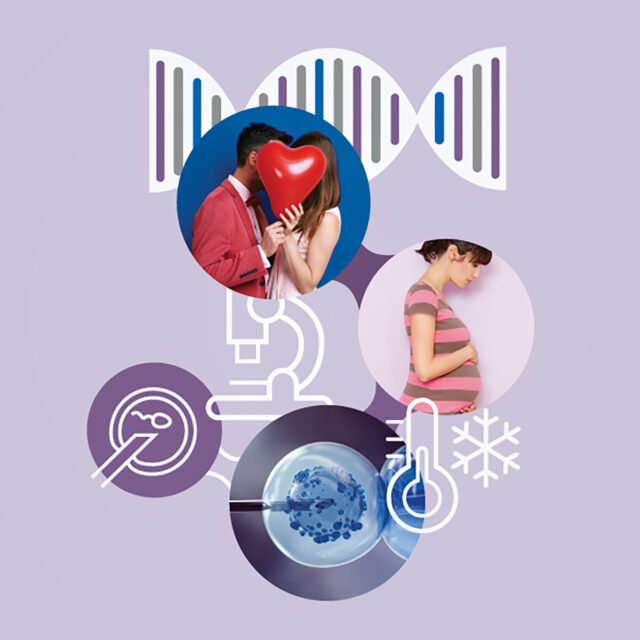Infertility has become one of the major reproductive problems affecting a number of couples who are determined to having babies. Infertility may result from male, female or a combination of factors that prevent women from becoming pregnant. Fortunately, due to advances in fertility treatment, there are several safe and effective techniques that significantly improve the chances of pregnancy. Nonetheless, an awareness towards infertility should be raised early on, allowing for medical assistance provided by the expert reproductive specialists in a timely manner.
Natural process of pregnancy
Sperm are microscopic cells that are produced in testicles. Millions of sperm come out during each ejaculation. Among this amount, only 1 sperm cell meets with an egg for fertilization. Eggs are gamete cells in the ovaries. When an egg becomes mature, it is ready to be fertilized by the sperm cell. About halfway through each menstrual cycle, one mature egg leaves the ovary, called ovulation. The mature egg travels through the fallopian tube towards the uterus. This egg normally hangs out for 12-24 hours for fertilization, slowly moving through the fallopian tube and waiting for any sperm around. If semen gets in the vagina, the sperm can swim up through the cervix, uterus and eventually into the fallopian tubes, looking for the egg. When the sperm cell fuses with the egg, it is called fertilization. Subsequently, the fertilized egg moves along the fallopian tube toward the uterus. It begins to divide into more cells, forming a blastocyst. The lining of the uterus (endometrium) prepares for the developing blastocyst to attach to it, known as implantation. As blastocyst grows, it becomes an embryo with further developments. Several internal changes and processes are involved before a pregnancy begins. If any abnormality occurs during any process or change, it potentially leads to infertile condition, resulting in the impaired chances of getting pregnant.
Get to know infertility
Infertility is defined as not being able to get pregnant despite having frequent, unprotected sexual intercourse for at least a year. However, women aged over 35 who cannot be pregnant might be considered age-related infertility in spite of having regular, unprotected sexual intercourse for at least 6 months. Infertility largely affects at least 15% of couples worldwide.
Causes of infertility
All of the steps during ovulation and fertilization need to happen correctly in order to get pregnant. Infertility can be caused by male or/and female factors. Nevertheless, the exact cause of infertility cannot be addressed in some cases. Five common causes of infertility include:
- Ovulation disorders
Abnormal ovulation accounts for 25% of couples with infertile problem. Ovulation disorders affect the release of eggs from the ovaries. Women can easily detect their ovulation period by using self-checking ovulation kit available over-the-counter. Self-checking ovulation kit is a urine-based strip test to identify impending ovulation by detecting the presence of luteinizing hormone (LH) in the urine. Luteinizing hormone is a hormone produced in the anterior pituitary gland. In females, an acute rise of LH triggers ovulation and development of the corpus luteum. The LH surge usually happens 24-36 hours before ovulation, therefore it is used as a predictive indicator for suspected ovulation period and optimal timing for sexual intercourse to maximize the chance of natural pregnancy. To interpret the test result, there are 2 lines: control line and test line. If the test line shows up similar to the control line, it is an LH surge. However, there are always low levels of LH in the body, so if the test line appears lighter or fainter than the control line, it is not yet an LH surge. Although this is easy and convenient, there are certain limitations caused by false negative result in which LH level actually rises but it cannot be detected due to improper timing. In addition, unclear result (test line appears lighter than control line) cannot be used as a precise indicator for predicting ovulation, thus it becomes difficult to determine an optimal time for having sexual intercourse.
Another approach to accurately detect ovulation is transvaginal ultrasound. A transvaginal ultrasound is a relatively simple procedure. While lying on the back, a transducer is inserted into the vagina. The probe sends out sound waves that bounce off of the ovaries and uterus which are then received by a computer and turned into images on a screen. Since transvaginal ultrasound can visualize the ovaries, it can measure the size of follicle and identify the dominant follicle to be ovulated and released from the ovary into the fallopian tube. Due to certain hormones in the body largely interfere with ovulation, the reproductive specialist might consider further investigations in women with ovulation abnormalities. Additional tests usually include blood test for thyroid hormone and prolactin hormone. Ovulation medications in the dosage form of oral tablet and injection might be prescribed in some cases.
As women age, the quantity and quality of eggs significantly decline. Therefore, advancing age becomes one of the major factors contributing to infertile problem. Ovarian reserve is conducted to determine the capacity of the ovary to provide egg cells that are capable of fertilization, resulting in a healthy and successful pregnancy. Ovarian reserve can be measured by different methods such as blood test for AMH (anti-mullerian hormone) which is a hormone secreted by cells in developing follicles. A low level of AMH in a woman’s blood is generally an indicator of poor ovarian reserve. Another method to determine ovarian reserve is transvaginal ultrasound with antral follicle count. An antral (resting) follicle is a small, fluid-filled sac that contains an immature egg. Antral follicle count is performed transvaginally in the early phase of menstrual cycle, in which reproductive specialist visually counts the number of egg-containing follicles that are developing on both ovaries. The high amount of antral follicles indicates that the ovaries function properly.
Evaluation of ovarian reserve is beneficial to infertility treatment. It can greatly help to precisely estimate the number of eggs that grow after receiving ovulation medications, both oral and injection forms.
Ovarian reserve testing allows for the estimation of success rate of IVF (In Vitro Fertilization) while enhancing safety and minimizing risks caused by ovarian hyperstimulation syndrome (OHSS) which occurs when women receive an excess egg stimulation and the ovaries swell and there will be fluid leakage into the body.
- Fallopian tube damage or blockage
Fallopian tubes reserve a vital function for natural conception process since in the presence of sperm and fertilization, the fallopian tubes transport the fertilized egg to the uterus for implantation. Fallopian tube damage or blockage is often caused by inflammation of the fallopian tubes (salpingitis). This can result from pelvic inflammatory disease, which is usually caused by a sexually transmitted infection, endometriosis or adhesions. Hysterosalpingography (HSG) is a radiologic procedure to investigate the shape and patency of the fallopian tubes. It is a special x-ray using dye to look for any damage or obstruction in the fallopian tubes. If certain forms of blocked fallopian tubes are detected from HSG, laparoscopic gynecologic surgery might be additionally required to further investigate the physiology of fallopian tubes and simultaneously repair the damaged area, if needed. If the result obtained from HSG and/or laparoscopic surgery reveals the complete occlusion of both fallopian tubes, natural conception or IUI (Intrauterine Insemination) is not an option. In such a case, only IVF (In Vitro Fertilization) can be considered to treat infertility. In some women present with tubal obstruction with hydrosalpinx (blocked fallopian tube is filled with serous or clear fluid near the ovary), it is highly recommended to surgically remove the whole fallopian tube, known as laparoscopic salpingectomy. After removal of damaged fallopian tubes, embryo obtained from IVF process can be then transferred into the uterus.
- Abnormal sperm production or function
Considering a major cause of infertility, abnormal sperm accounts for 40% of infertile couples. To determine male infertility, semen analysis is conducted to evaluate the quality of sperm which substantially affects the chance of pregnancy. Semen analysis helps determine sperm quantity, sperm motility (the ability of sperm to move efficiently through the female reproductive tract to reach the mature egg for fertilization) and sperm morphology (the shape of sperm). To collect semen, it is required to refrain from ejaculation (both sexual intercourse and masturbation) for 3-7 days prior to semen collection. The specimen must be collected by masturbation and kept in the sterile specimen container. The entire ejaculate should be collected. Collected specimen needs to be delivered to the laboratory immediately or within an hour after collection. If the result derived from semen analysis indicates the abnormality of sperm, further tests or procedures might be considered, such as blood test for certain hormones and testicular biopsy – a surgical removal of a small portion of testicle for examination. If azoospermia defined as the complete absence of sperm from the ejaculate (semen) is confirmed or other medical conditions related to testicles are suspected, for instance, abnormal testicles and varicocele – an enlargement of the veins within the loose bag of skin that holds the testicles, medical assistance and investigations conducted by the urologist are further required.
- Uterine or cervical abnormalities
Abnormalities of the uterus can contribute to the inability to become pregnant. These often include certain congenital uterine anomalies (malformations of the uterus that develop during fetal life), submucous myomas (uterine fibroids located under the mucosal layer and protruding into the uterine cavity), endometrial polyp (overgrowth of cells in the lining of the uterus) and intrauterine adhesions (bands of fibrous tissue that form in the endometrial cavity). These uterine conditions can distort the endometrial cavity, making it difficult for embryo implantation. In addition, the chance of miscarriage considerably increases if these uterine problems develop without appropriate treatments. Further investigations are necessarily required, including imaging tests e.g. ultrasound and MRI of the pelvis. In women present with congenital uterine anomalies, other procedures might be indicated e.g. saline instillation sonohysterography (a procedure in which saline is instilled into the uterine cavity transcervically to provide enhanced endometrial visualization by ultrasound) and diagnostic hysteroscopy (a procedure in which hysteroscope, a thin, lighted tube is inserted into the vagina to examine the cervix and inside of the uterus).
In some women after undergoing LEEP (loop electrosurgical excision procedure) using a wire loop heated by electric current to remove abnormal cells in the cervix, there appears to be significant detrimental effect of LEEP on future fertility due to the irregular shape of cervix or changes and scarring in the cervix from the removal of tissue. These groups of women also possess a higher risk of encountering with preterm labor, comparing with general population.
- Peritoneal abnormalities
The peritoneum is a serous membrane which lines the walls of the abdominal cavity and lies on abdominal and pelvic organs, covering the uterus, fallopian tubes and ovaries. Peritonitis (inflammation of the peritoneum) and endometriosis (endometrial tissue grows outside of the uterus) may affect the function of the ovaries, uterus and fallopian tubes. These may potentially lead to scar formation and adhesion, affecting the functional lining of the uterus. This also can be a reason for infertility. These conditions are frequently found in 35% of infertile women who have had no other specified cause of infertility. The common symptoms that urge medical attention are painful menstruation (dysmenorrhea), chronic abdominal cramping and pain during sexual intercourse. Nevertheless, some patients might not experience any abnormal sign or symptom. Diagnostic procedure involves a gynecological laparoscopy which is a minimally invasive surgery to examine the uterus, fallopian tubes and ovaries through small incision by using a laparoscope. Gynecological laparoscopy can be used to diagnose a wide range of gynecological conditions, including endometriosis, pelvic adhesions and ovarian or chocolate cysts. Concurrently, if any abnormality is detected, it can be treated at the same time. Moreover, laparoscopic procedure can be conducted simultaneously with chromopertubation, a procedure to investigate the patency of the fallopian tubes by passing the colored dye through the cervix and the fallopian tubes.
Unexplained infertility
Unexplained infertility is an idiopathic infertility in which its cause remains unknown even after an infertility work-up, including semen analysis in the man and assessment of ovulation and fallopian tubes in the woman. Unexplained infertility accounts for 10% of infertile couples who seek for fertility treatments. The first recommended approach in couples with unexplained infertility is IUI (Intrauterine Insemination). If IUI fails (after 3-6 cycles), next approach to enhance the chance of pregnancy is IVF (In Vitro Fertilization).
Determining the cause of infertility
Statistical data points out that at least 25% of infertile couples have had combined contributing factors to inability to get pregnant. Therefore, it is vital to seek medical assistance from a expert reproductive specialist. Assessment and investigation of both men and women are required in order to address the exact cause (s) of infertility, allowing for effective treatments. Common issues that are normally discussed include:
- The frequency of menstrual cycle, length and variation
- Abdominal pain during menstrual period
- Abnormal vaginal bleeding or the medical history of pelvic inflammatory disease
- History of previous pregnancy or miscarriage
- Contraceptive method (s) used in the past
- Man’s history related to sperm problems, such as previous testicular injury or surgery and sexual transmitted diseases e.g. gonorrhea and syphilis
- Information in regard to sexual intercourse e.g. the frequency of having sex in a week, difficulty or pain either in the vagina or deeper in the pelvis during sex, erectile dysfunction (impotence) and ejaculation problems.
These problems play a significant role in prohibiting the natural conceiving process, resulting in inability to get pregnant naturally. Nonetheless, the root causes of infertility are often seen in conjunction with other factors.
Aside from family counseling and investigation of the infertility’s causes, additional plans and instructions for a healthy pregnancy will be thoroughly advised by the reproductive specialist. Recommendations include appropriate diet consumption, essential supplements and vitamins before getting pregnant, alcohol or illicit drug cessation and certain drugs that affect fetus and should be avoided during pregnancy as well as prenatal genetic screening tests for some genetic disorders.
If you have been experiencing trouble related to infertility, new advancements in fertility treatment can substantially raise the hope for having babies. Fertility treatments include IUI (Intrauterine Insemination), IVF (In Vitro Fertilization), ICSI (Intracytoplasmic Sperm Injection) and advanced technology as PGTA (preimplantation genetic testing for aneuploidies) and PGT-M (preimplantation genetic testing for monogenic disorders). Among different techniques, the most effective approach will be chosen based primarily on each couple’s conditions. Fertility Center, Bangkok Hospital is committed to deliver a comprehensive fertility care by our highly experienced reproductive specialists and multidisciplinary team. Assured by international standards, our center is well-equipped with a range of advanced fertility technologies and services to achieve the best possible outcome of pregnancy.











